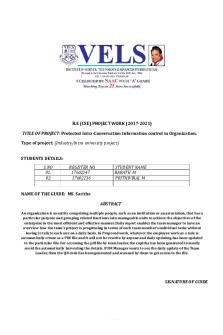Computer Project 1 - PJ1 PDF

| Title | Computer Project 1 - PJ1 |
|---|---|
| Course | Random Signals And Noise |
| Institution | Duke University |
| Pages | 2 |
| File Size | 187.5 KB |
| File Type | |
| Total Downloads | 83 |
| Total Views | 135 |
Summary
PJ1...
Description
ECE 581K Computer Project 1 Reference: Introduction to Probability by Charles M. Grinstead and J. Laurie Snell, free open book at http://www.dartmouth.edu/~chance/teaching_aids/books_articles/probability_book/amsbook.mac.pdf Computer Simulation Problems: 1. Please use Example 2.3 in the Grinstead book to simulate the Buffon’s Needle experiments. Please calculate, simulate and store the estimated number of π using 100,1000,10000,100000 trials, and plot the estimated numbers to visualize the convergence. 2. Consider n people who are attending a class and n is smaller than 200. We assume that every person has an equal probability of being born on any day during the year, independently of everyone else, and ignore the additional complication presented by leap years (i.e., nobody is born on February 29, we have 365 days for one year). What is the probability that for all n people each person has a distinct birthday? Please calculate and simulate the P(n) and plot the p(n) against n to visualize the trend. 3. Draw the top 7 cards from a well-shuffled standard 52-card deck. Find the probability that the 7 cards include exactly 3 Kings. Please solve it mathematically and use computer simulation to prove your solution. 4. Please use simulation to estimate the area under the graph of y = 1/(x + 1) in the unit square (x in [0,1],y in [0,1])in the same way as in Fig 2.3 of the Grinstead book. Calculate the true value of this area and use your simulation results to estimate the value of log 2. How accurate is your estimate?
5. A coin is tossed three times. What is the probability that exactly two heads occur, given that a. the first outcome was a head? b. the first outcome was a tail? c. the first two outcomes were heads? d. the first two outcomes were tails? e. the first outcome was a head and the third outcome was a head? Please calculate the mathematical solution first and then use simulation to verify the answer.
6. An urn contains 4 red balls and 2 black balls. Two balls are chosen at random and without replacement. What is the probability of obtaining one red ball and one black ball in any order? Please derive the answer using both calculation and simulation. 7.
8. Compare hypergeometric and binomial distribution when N is large
9. Geometric distribution
10. Use Binomial random variable to approximate a Poisson random variable, plot the PMF
11. Calculate the following probabilities and use computer simulation to verify the results 12. The way to simulate random variables directly from a standard uniform random variable is introduced here at: https://personal.utdallas.edu/~pankaj/3341/FALL05/NOTES/lecture_week_8.pdf Please read the document and try to use the standard uniform sampling (e.g. rand()) function only to perform computer simulation and verify the expectation and variance of the Geometric distribution and the exponential distribution....
Similar Free PDFs

Computer Project 1 - PJ1
- 2 Pages

Computer architecture lab 1
- 17 Pages

Computer Programming Laboratory 1
- 10 Pages

Assessment 1 for Computer
- 36 Pages

Assignment 1 - Computer Systems
- 32 Pages

Computer Network quiz-1
- 2 Pages

Human Computer Interaction 1
- 5 Pages

Project 1
- 1 Pages

Project 1
- 2 Pages

Project 1
- 12 Pages

Project 1
- 5 Pages

Project 1
- 2 Pages

Computer Lab 1 (Week 1) - Lab 1
- 15 Pages

Lab 1 Disassemble a Computer
- 3 Pages
Popular Institutions
- Tinajero National High School - Annex
- Politeknik Caltex Riau
- Yokohama City University
- SGT University
- University of Al-Qadisiyah
- Divine Word College of Vigan
- Techniek College Rotterdam
- Universidade de Santiago
- Universiti Teknologi MARA Cawangan Johor Kampus Pasir Gudang
- Poltekkes Kemenkes Yogyakarta
- Baguio City National High School
- Colegio san marcos
- preparatoria uno
- Centro de Bachillerato Tecnológico Industrial y de Servicios No. 107
- Dalian Maritime University
- Quang Trung Secondary School
- Colegio Tecnológico en Informática
- Corporación Regional de Educación Superior
- Grupo CEDVA
- Dar Al Uloom University
- Centro de Estudios Preuniversitarios de la Universidad Nacional de Ingeniería
- 上智大学
- Aakash International School, Nuna Majara
- San Felipe Neri Catholic School
- Kang Chiao International School - New Taipei City
- Misamis Occidental National High School
- Institución Educativa Escuela Normal Juan Ladrilleros
- Kolehiyo ng Pantukan
- Batanes State College
- Instituto Continental
- Sekolah Menengah Kejuruan Kesehatan Kaltara (Tarakan)
- Colegio de La Inmaculada Concepcion - Cebu

